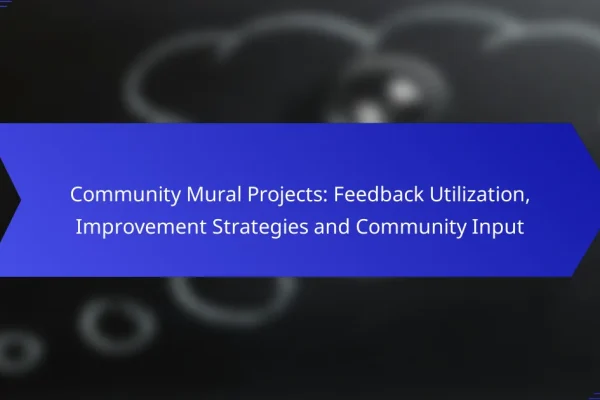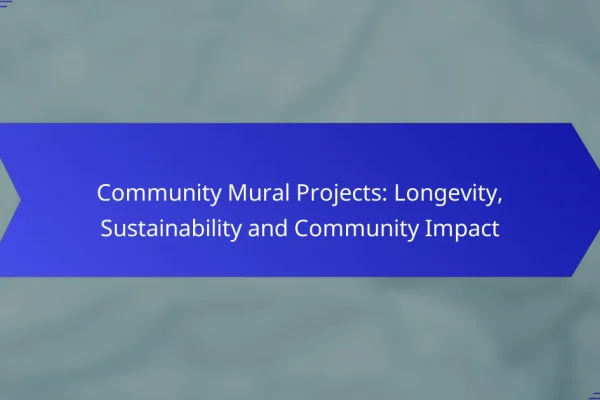How to evaluate community mural projects in urban areas?
Evaluating community mural projects in urban areas involves assessing engagement, artistic quality, and overall impact. These factors help determine the project’s effectiveness in enhancing community identity and fostering social connections.
Assess community engagement
Community engagement is crucial for the success of mural projects. Evaluate how many residents participated in the planning and execution phases, as well as their ongoing involvement in maintenance and promotion. High levels of participation often indicate stronger community ownership and pride.
Consider conducting surveys or interviews with local residents to gather feedback on their perceptions and involvement. Look for evidence of collaboration among diverse community groups, which can enhance the mural’s relevance and acceptance.
Analyze artistic quality
Artistic quality plays a significant role in the overall impact of a mural. Assess the technical skills of the artists involved, including their use of color, composition, and style. High-quality artwork can attract attention and foster appreciation within the community.
Additionally, consider how well the mural reflects local culture and history. A mural that resonates with the community’s identity can create a stronger emotional connection and encourage ongoing engagement.
Evaluate project impact
To evaluate the impact of a mural project, examine both qualitative and quantitative outcomes. Look for changes in community pride, increased foot traffic, or enhanced local business activity following the mural’s completion. Surveys can help gauge shifts in community sentiment and engagement levels.
Additionally, consider the mural’s role in addressing social issues or promoting dialogue within the community. A successful mural project should contribute positively to the urban environment and foster a sense of belonging among residents.
What criteria should be used for selecting mural projects?
When selecting mural projects, key criteria include artistic vision, community relevance, and budget considerations. These factors ensure that the murals not only enhance the visual landscape but also resonate with local residents and stakeholders.
Artistic vision and style
The artistic vision and style of a mural should align with the community’s identity and values. Consideration of the artist’s previous work and their ability to convey meaningful narratives through their art is essential. Engaging local artists can foster a sense of ownership and pride among residents.
It’s beneficial to review a portfolio of the artist’s past projects to assess their style and thematic focus. This can help ensure that the mural will be visually appealing and culturally relevant.
Community relevance
Community relevance is crucial for the success of a mural project. The chosen theme should reflect local history, culture, or issues that resonate with residents. Engaging community members in the planning process can provide valuable insights and foster support.
Consider hosting workshops or surveys to gather input on potential themes. This collaborative approach not only enhances relevance but also builds community buy-in, which can be vital for the project’s longevity.
Budget and funding sources
Budgeting is a critical aspect of mural projects, as costs can vary widely based on size, materials, and artist fees. Establishing a clear budget early on helps in identifying feasible projects and avoiding financial pitfalls. Typical costs can range from a few thousand to tens of thousands of dollars, depending on the project’s scope.
Funding sources may include local government grants, community fundraising, or sponsorship from local businesses. Exploring multiple funding avenues can increase the likelihood of project success and sustainability.
What are the best practices for community mural project implementation?
Effective community mural project implementation involves careful planning, local artist involvement, and strategies for sustainability. These practices ensure that the mural reflects community values and remains a lasting asset.
Collaborative planning
Collaborative planning is essential for aligning the mural project with community needs and aspirations. Engage local stakeholders, including residents, businesses, and organizations, to gather input and build support. This can be done through workshops, surveys, or community meetings.
Establish a clear project timeline and budget during the planning phase. Consider potential challenges, such as site selection and permitting, and develop strategies to address them. A well-defined plan helps streamline the implementation process and fosters community ownership.
Incorporating local artists
Involving local artists not only enhances the mural’s authenticity but also supports the local creative economy. Seek out artists who have a connection to the community and understand its culture. This can lead to designs that resonate more deeply with residents.
Consider hosting artist selection events or competitions to encourage participation. Provide artists with a platform to showcase their work and engage with the community, fostering a sense of pride and ownership in the mural.
Ensuring sustainability
Sustainability is crucial for the long-term success of community mural projects. Use high-quality, weather-resistant materials to ensure the mural withstands environmental factors. Regular maintenance, such as cleaning and touch-ups, can prolong the mural’s lifespan.
Establish a maintenance plan that includes community involvement. Encourage local groups to take responsibility for upkeep, which can strengthen community ties and ensure the mural remains a vibrant part of the neighborhood for years to come.
What are the challenges faced in community mural projects?
Community mural projects often encounter several challenges that can hinder their success, including funding limitations, community opposition, and maintenance issues. Understanding these obstacles is crucial for effective planning and execution.
Funding limitations
Securing adequate funding is one of the primary challenges in community mural projects. Many initiatives rely on grants, donations, or community fundraising, which can be unpredictable and insufficient. It’s essential to create a detailed budget and explore multiple funding sources to increase financial stability.
Consider applying for local arts grants or partnering with businesses for sponsorships. Engaging the community in fundraising events can also help raise awareness and support for the project.
Community opposition
Community opposition can arise from differing opinions about the mural’s design, location, or purpose. Some residents may feel that a mural does not align with their vision for the neighborhood or may have concerns about its impact on property values. Addressing these concerns early in the planning process is vital.
Organizing community meetings to gather input and feedback can foster a sense of ownership and collaboration. Presenting the benefits of the mural, such as beautification and cultural expression, can also help mitigate resistance.
Maintenance issues
Maintenance is a significant concern for community murals, as weather, vandalism, and general wear can diminish their appearance over time. Planning for ongoing upkeep is essential to ensure the mural remains vibrant and respected. This may involve establishing a maintenance schedule and securing funds for repairs.
Involving local artists in the maintenance process can also promote community engagement and pride. Creating a volunteer group dedicated to mural care can help sustain the project long-term while fostering a sense of community responsibility.
How do community mural projects benefit neighborhoods?
Community mural projects provide numerous benefits to neighborhoods by enhancing visual appeal, fostering social connections, and promoting local culture. These initiatives can transform public spaces, making them more inviting and engaging for residents and visitors alike.
Enhance local identity
Mural projects can significantly enhance local identity by reflecting the unique culture and history of a neighborhood. They often incorporate elements that resonate with community members, such as local landmarks, historical figures, or cultural symbols.
By showcasing these themes, murals can create a sense of belonging and pride among residents, making them feel more connected to their surroundings. This visual representation of local identity can also serve as a conversation starter and a point of interest for newcomers.
Attract tourism
Murals can attract tourism by turning neighborhoods into vibrant art destinations. Visitors are often drawn to areas with striking public art, which can lead to increased foot traffic and economic activity.
To maximize this benefit, communities can organize mural tours or events that highlight the artwork and its creators. This approach not only promotes the murals but also supports local businesses, as tourists are likely to spend money at nearby shops and restaurants.
Foster community pride
Community mural projects can foster pride by involving local artists and residents in the creation process. When community members participate in designing and painting murals, they develop a sense of ownership and investment in the artwork.
Moreover, successful mural projects can inspire further community initiatives, encouraging collaboration and engagement among residents. This collective effort can strengthen social ties and enhance the overall quality of life in the neighborhood.
What are successful examples of community mural projects?
Successful community mural projects typically engage local artists and residents, fostering collaboration and cultural expression. These projects can enhance public spaces, promote community identity, and address social issues through art.
Philadelphia Mural Arts Program
The Philadelphia Mural Arts Program is one of the largest public art programs in the United States, known for transforming blank walls into vibrant murals. It began in the 1980s as an anti-graffiti initiative and has since evolved to include community engagement and education.
This program involves local artists and community members in the mural creation process, ensuring that the artwork reflects the neighborhood’s identity and history. Participants often attend workshops and contribute ideas, making the project a collaborative effort that strengthens community bonds.
To get involved, communities can apply for funding through local grants or partner with organizations that support public art. Successful projects often have clear goals, such as beautifying a space or addressing social issues, and include ongoing maintenance plans to keep the murals vibrant.











